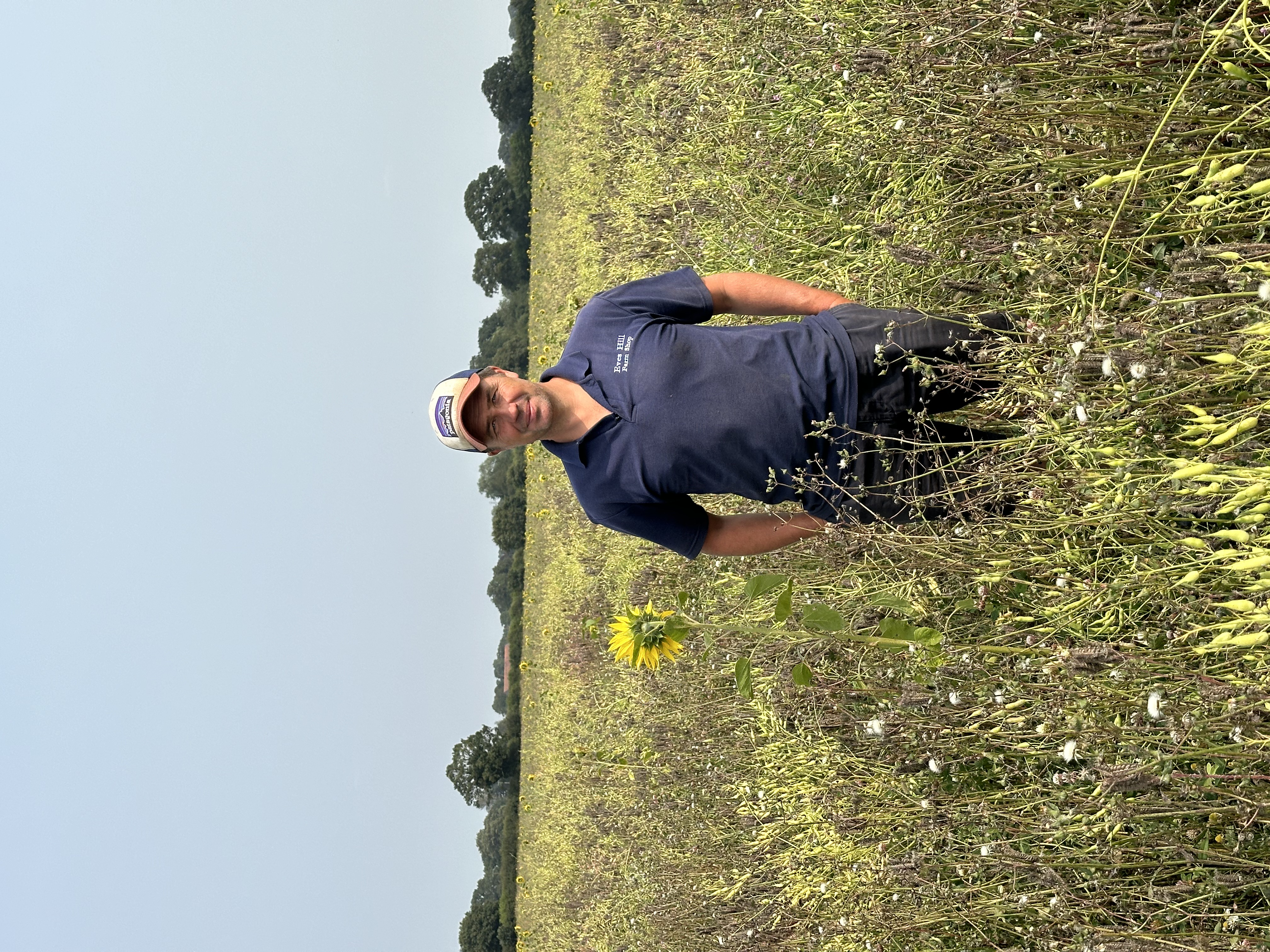

Farm Type: Mixed Regenerative & SFI Norfolk
Location: Norfolk
Size: 250 Acres
Soil Type: Sandy Loam
Mixes Used: Cover Crops, SFI & Herbal Leys
‘Cotswold Seeds are an integral part of our regenerative journey. There’s a point in the year where every single one of our fields has Cotswold Seeds mixtures growing in it.’
The farm is used to grow cereals, cover crops and herbal leys, with livestock enterprises including a beef suckler herd and pigs producing meat for their farm shop. The beef cattle are 100% grass fed, grazing on the herbal leys that are part of the arable rotation and on cover crops throughout the winter. ‘The cows are producing nutrient rich beef for our shop and also helping to regenerate our soil.’
The herbal leys were sown five years ago, conventionally established by creating a seed bed using the Sumo and then drilling with a Vaderstad drill. Jeremy says they’ve produced a ‘fantastic amount of forage’ as they work to restructure the soil and improve soil biology. ‘On school visits we explain how the different rooting depths of the 18 plants mine different minerals and nutrients, drawing them up into the plants which are eaten by the cows and when we then eat the beef, we take on board all the nutrients.’
Jeremy describes SFI as a ‘game changer for a small farm like ours. The bespoke SFI Cover Crop and SFI/NUM3 Summer Legume Fallow mixtures from Cotswold Seeds, are fast-tracking our regenerative journey.’ The Summer Legume Fallow mixture includes phacelia, clover and vetches. Planted in spring, it produces ‘a beautiful mass of biodiversity that is brilliant for pollinators and small mammals.’
Jeremy has been trialling different methods of establishment. ‘Historically, we’ve put the cover crops in with an air seeder. Or we’ve used a stronger tillage machine like a Sumo, followed by a drill.’ His preferred method for termination is grazing. ‘We bring the cattle in to graze it off before going into winter wheat.’
After a spell working in media and living in Paris, Jeremy Buxton returned to the 250 acre family farm in Norfolk in 2012, where he and his wife embarked on a ‘regenerative journey’ driven by a desire to protect the farm and the planet for future generations.
‘I’ve got kids and I want them to have a future,’ Jeremy says. ‘So I wanted to ensure we have healthy living soils that we can farm for decades to come. We want to do our bit for biodiversity and climate change. I think farmers can have a massive impact and be the heroes in this whole situation.’
Gabe Brown’s book Dirt to Soil was a huge inspiration. Jeremy says it opened his eyes to what was happening globally in regards to climate change and was the real push towards changing the way he farmed. ‘It showed me that soil is our most important asset. So every decision we make now, we are asking ourselves, what effect that will have on the health of our soil? We want to demonstrate that farming, nature and the environment can work together.’
The farm is used to grow cereals, cover crops and herbal leys, with livestock enterprises including a beef suckler herd and pigs producing meat for their farm shop. The beef cattle are 100% grass fed, grazing on the herbal leys that are part of the arable rotation and on cover crops throughout the winter. ‘The cows are producing nutrient rich beef for our shop and also helping to regenerate our soil.’
The herbal leys were sown five years ago, conventionally established by creating a seed bed using the Sumo and then drilling with a Vaderstad drill. Jeremy says they’ve produced a ‘fantastic amount of forage’ as they work to restructure the soil and improve soil biology. ‘On school visits we explain how the different rooting depths of the 18 plants mine different minerals and nutrients, drawing them up into the plants which are eaten by the cows and when we then eat the beef, we take on board all the nutrients.’
Jeremy describes SFI as a ‘game changer for a small farm like ours. The bespoke SFI Cover Crop and SFI/NUM3 Summer Legume Fallow mixtures from Cotswold Seeds, are fast-tracking our regenerative journey.’ The Summer Legume Fallow mixture includes phacelia, clover and vetches. Planted in spring, it produces ‘a beautiful mass of biodiversity that is brilliant for pollinators and small mammals.’
Jeremy has been trialling different methods of establishment. ‘Historically, we’ve put the cover crops in with an air seeder. Or we’ve used a stronger tillage machine like a Sumo, followed by a drill.’ His preferred method for termination is grazing. ‘We bring the cattle in to graze it off before going into winter wheat.’
This spring he pushed the boundaries. The field of spring barley was inter-seeded by drones into the standing crop, pre-harvest. ‘It was a mix that Sam at Cotswold Seeds put together for us, including mustard, radish, forage rape, turnips and some clover. In his experience the small seeded brassica seeds have been most reliable if broadcasting; they are thin shelled and do not need much moisture to germinate from a surface sowing. We decided to try the drones as they ticked many boxes for what we are trying to achieve in our regen system, such as minimal soil disturbance.’
'I really believe that farmers can be the heroes in the fight to halt climate change and stopping biodiversity losses, by adopting regenerative management and practises.'
Jeremy’s ultimate aim is to move away from growing global commodity crops and grow food for his local community, selling all farm produce direct from Eves Hill Farm. He believes in farming with nature, with the help of Cotswold Seeds. Cotswold Seeds are ‘an integral part of our regenerative journey. There’s a point in the year where every single one of our fields has Cotswold Seeds mixtures growing in it.’
Date Posted: 9th July 2025



